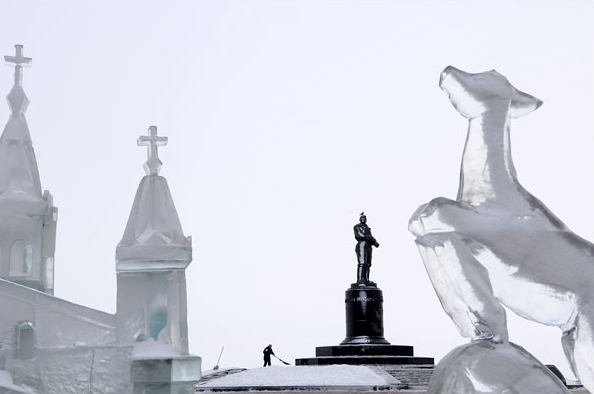If you type “democracy” into Google Images you will see one of the more motley and uninspiring slide shows possible. Bad editorial cartoons, messy posters, conventional book covers, not so snappy bumper stickers, a video game, an Internet TV platform, a monument in Bangkok, and my personal favorite: the king of Nepal wearing a floral garland. Most of these are not images from photojournalism. The two iconic images from Tiananmen Square each put in an appearance, along with a few snaps of protesters holding signs, but, again, the record is not distinguished.
This poor showing may be an oddity of the search engine but should not be surprising. Democracy is a set of beliefs, practices, and institutions each of which includes assumptions about the world that are partially metaphysical. I can show you a traffic light, but not “rule of law.” People voting, but not “the will of the people.” A flag, but not “liberty and justice for all.” So it is that we are drawn to documenting political and ethical failures, and to relying on iconic images and other symbols. One can document crime, privilege, and injustice, and a monument or photograph can evoke reaffirmation of our democratic ideals.
These thoughts were brought to mind by an image accompanying a Sunday New York Times story on the erosion of democracy in Russia during the Putin regime. Interestingly, the story was published in Russian on the previous Friday at a Times Russian website, and some of the 3000 comments were translated for a story in the US on Monday. The comments suggest that democratic debate is alive and well in the Russian blogosphere, with the added value of having devotees of authoritarian rule being able to voice their sentiments directly rather than code them as family values. But I digress.
The question I want to raise was provoked by the first photograph in the 13-photo slide show accompanying the article:
This stunning image is captioned as “Nizhny Novgorod, an industrial center with 1.3 millian residents, was known as Gorky during the Communist era, when it was closed to foreigners and was home to the dissident physicist Andrei D. Sakharov, who was sent into internal exile here. After the Soviet Union’s collapse, it became a hotbed of liberalism. Today, authority flows from the Kremlin to a regional governor appointed by President Vladimir Putin.”
If you read all of that without having your eyes glaze over, you’re ahead of me. I can’t help but note that the 66 words fail to identify the specific place being photographed or the subject of the the large statue in the center of the frame. Likewise, there is no evident reason to believe that what is being shown has anything specific to do with industrialization, Gorky, Communism, or Sakharov. I believe that we are looking at the statue memorializing Valery Chkalov, a Soviet test pilot killed in 1938, but you wouldn’t know it from the Times. In any case, that allusion to Soviet engineering is topped visually on either side by the Orthodox crosses and deer immortalized in ice.
So, what are we being shown with this photograph? One answer is merely aesthetic: it’s a visually striking image, what more do you need to know? I don’t doubt that had something to do with its being selected for the slide show, but it will not account for the full range of effects. We think with images, and this image will make it easier to imagine one Russia rather than another. Apparently, the news is not good. Although technically a color photograph, the scene seems a natural grayscale. The cold, hard, metallic monument sets the tone; its black sheen is the most vital thing in the picture, as if it were a monument to Darth Vadar on the Ice Planet. Inanimate objects surrounded by a vast, empty, public space and a featureless winter sky: Welcome to Nizhny Novgorod.
The “new city” was founded in 1221, and the photograph’s symbolism all but keeps us there. Nature and the church–a bastion of traditional pieties–surround a lifeless monument; Mother Russia envelops a hard core of authoritarian metal. The people are represented by a lone worker and his tools, which appear antiquated. So much for the people’s republic, vanguard of progress, and one has to wonder if a democratic people could fare any better in such a frozen place.
Unlike his counterpart in the US, I haven’t looked into Putin’s soul, but I wouldn’t trust him with the garbage. Even so, those committed to democracy should do more than point to its threats. If democracy is to succeed in Russia, it may need help from citizens elsewhere. (The US did.) We may not be able to see democracy, but it does require imagination. If we have already concluded that Russia is fundamentally cold, harsh, and naturally authoritarian, we do them no favor. Images such as the one above are visually distinctive, but they may be a political mistake.
Photograph by James Hill/New York Times.

[…] emergencemarketing.com wrote an interesting post today onHere’s a quick excerpt If you type “democracy” into Google Images you will see one of the more motley and uninspiring slide shows possible. Bad editorial cartoons, messy posters, conventional book covers, not so snappy bumper stickers, a video game, an Internet TV platform, a monument in Bangkok, and my personal favorite: the king of Nepal wearing a floral garland. Most of these are not images from photojournalism. The two iconic images from Tiananmen Square each put in an appearance, along with a few snaps of protes […]